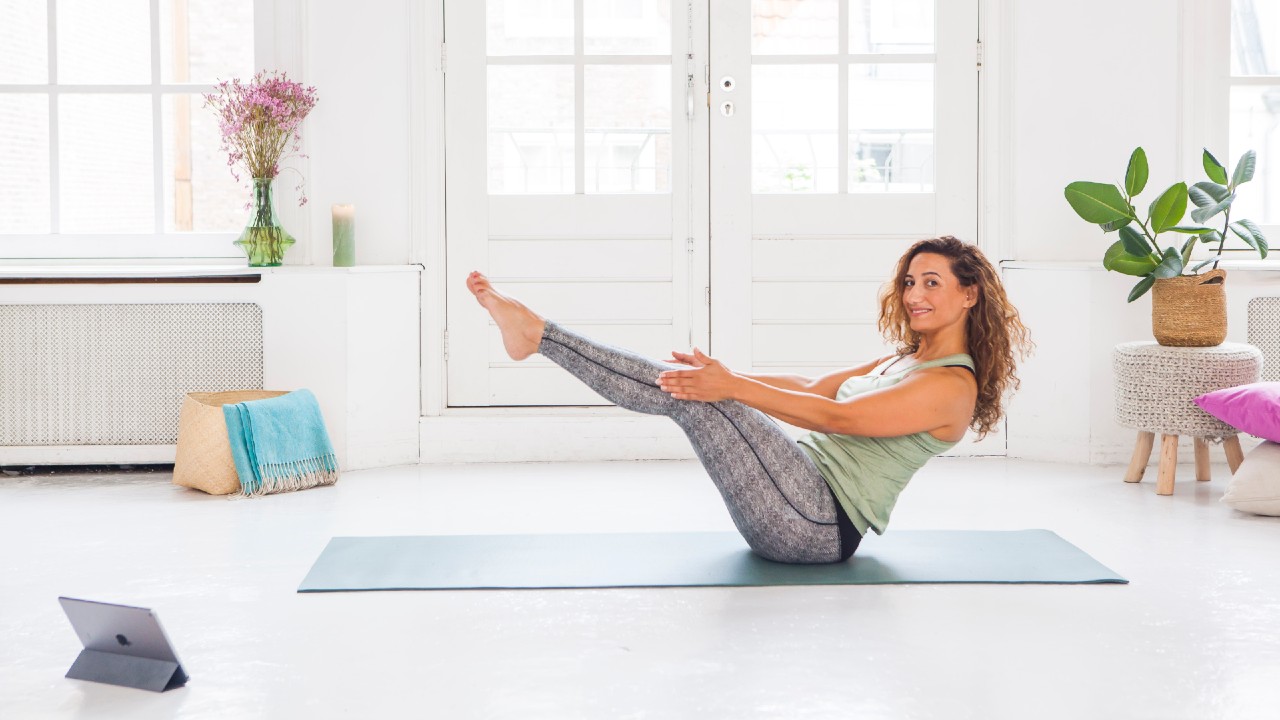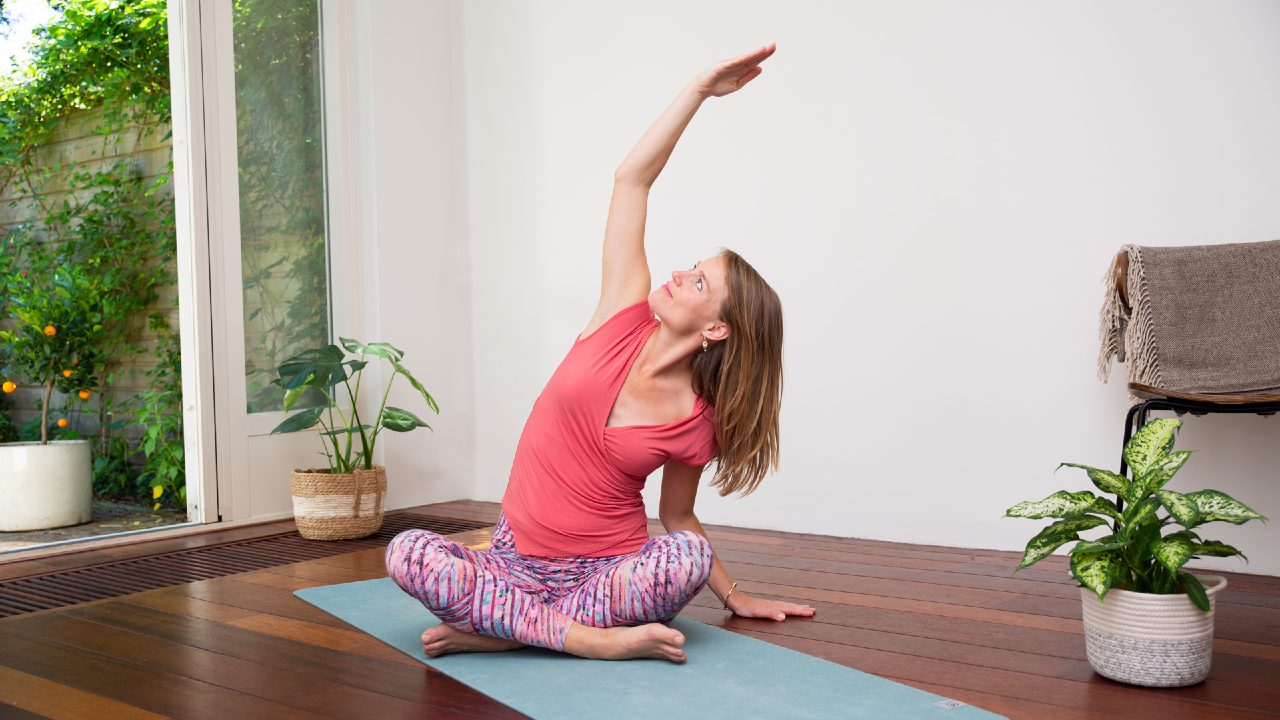Practicing yoga at home doesn’t just meet your needs of staying healthy and balanced – it also uniquely facilitates a self-love practice! Self-love underpins every genuine attempt at self-care – whether it’s a yoga practice, a desire to eat healthier foods, training for a marathon, or spending the day relaxing. When you drill down to the core desire of wellness, it’s to love yourself more. Sometimes, just reconnecting with this intention is enough to shift our priorities and mindset when it comes to self-care.
As a self-care coach, I hold my clients’ hands as they journey inward to meet themselves, know themselves, and love themselves more. So how do we love ourselves more? By becoming aware of our own needs, holding them with compassion and non-judgment, and skilfully meeting them. This requires, above all, the space to be vulnerable, empowered, and at home in our experience. Without feeling pressure to perform, keep up, or get it perfect, we just might experience self-acceptance and self-love. That’s where a home yoga practice comes in.
Without feeling pressure to perform, keep up, or get it perfect, we just might experience self-acceptance and self-love.
Be more vulnerable
From the privacy of your home, you don’t have to worry about anyone seeing you fall out of a pose, your underwear sticking out of your yoga pants, or that moment you need to stay in child’s pose a little longer. By being alone and totally open to all you are experiencing in each asana, you’re training yourself to be more in tune with your own needs. You can wear whatever you want (or nothing at all!), you can pause, rewind, and fast-forward to adjust the lesson to your needs. You may sacrifice the accountability of signing up for an in-person class, but – with an at home practice – you are in control.
On our self-love journey, control over when and where we are vulnerable is deeply empowering. We all need safe spaces to be fully honest without the perceived fear of social repercussions. For many people – especially people who fall outside of the oppressive body standards and beauty norms of society – traditional yoga studios can feel exclusive and even harmful. Feel empowered to push your boundaries by trying a completely new style of yoga (Budokon, Yamuna, Iyengar are all styles I had never even heard of before EkhartYoga!).
Be empowered
Speaking of vulnerability, you can feel free to modify those poses as you wish! While many teachers offer modification in class, it can be hard to give ourselves permission to modify while others are watching. Although we sometimes benefit from this accountability challenge, we may feel pressure to prioritize social belonging (i.e. trying to match the teacher and fellow students in the class) over listening to our own bodies.
Yoga is about balance – but why is there more emphasis than ever on the Yang practices of power yoga, core yoga, and hot yoga springing up in studios all over the world? Where are the Yin Yoga studios specializing in restoration, integration, and embodiment? While it may prove difficult to find such balance always in the yoga industrial complex, find it instead within your own at-home practice. Allow yourself to modify and truly listen to your body, as needed. Now you don’t have to wait until your studio’s Friday night candle-lit restorative yoga class to find these experiences. Light some candles, search for a “Yin Yoga” class on EkhartYoga and start unwinding and unraveling immediately.
Set the mood for your home practice
When you practice at home, you have the chance to create those yoga studio/retreat vibes within your sacred space! Light a few candles, burn some incense, play relaxing music. Some people dedicate entire rooms in their homes to yoga and meditation! Even if that’s not accessible for you, consider how you can set the tone in a corner or your backyard for regular practice. Hanging a plant or piece of art that puts you in a state of mindfulness will help set the tone. Keep your yoga mat, bolster, blocks and straps in view. Design the space so that, when you see it, you automatically desire to drop everything and practice yoga! Setting the mood not only helps ensure we practice, it also signals to our brain that there is a container, a safe space, in which to practice self-love.
Meet your own needs
Perhaps the best reason to practice on-demand yoga is schedule flexibility. You can seamlessly incorporate your practice into a larger self-care routine any time of day. Stumble out of bed, and right onto the yoga mat in the morning. If you work from home do some gentle stretching on your lunch break. At the end of the day, after Savasana, you can simply roll over and go to sleep! Let your home yoga practice hold you in moments of sudden desperation, anxiety, or pain. Yoga can become an automatic self-compassion response to life’s unscheduled pain.
Yoga can become an automatic self-compassion response to life’s unscheduled pain.
Simply hop onto your EkhartYoga dashboard and filter classes based on the length of time you have. Whether it’s five minutes or an hour, there’s something to fit every time window. The customization doesn’t end there – you can also filter by level, specific use, teacher or style based on what your body, mind, spirit is telling you it needs. Feeling like going slow and staying low to the ground? Try a search with terms like “slow” or “gentle”. Want something specifically for upping your depleted energy? Look for Vinyasas, or search the term “energizing”. When you actively search for the class, the thing that suits your unique needs at that moment, you are telling yourself that you can have your own back.
Listen to your body’s wisdom
In an at-home practice, you may feel safer to go deeper, close your eyes if your balance allows, and feel what each pose has to offer you. Consider yourself a body-wisdom channel. This means you trust the natural intelligence of your body, and actively seek to translate those messages for yourself.
You can practice this by paying attention with each pose – how does it feel? What muscles are being activated? What is being stretched? Do things feel worse, better, or the same as the last time you practiced? How quiet was your mind after the practice? Were you able to sit for longer in your post-yoga meditation?
Once you’re finished, take out your journal. Write about what showed up for you. You can even write a letter from a specific body part – my feet, psoas, and hips always have a lot to say. Sometimes these parts just want our attention and care. Other times, they have intuition contained within them about something that’s been on our minds. The point is to develop a relationship with your body as a source of guidance that you can lean on at any time.
Your journey begins
An at-home yoga practice can facilitate new experiences of self-love. The freedom to be more vulnerable, modify poses and classes as you see fit, set the mood for yourself, and practice whenever you want opens up room for knowing and loving yourself more. You can also find the space to lean into your body’s intuitive wisdom and guidance through witnessing and journaling after an at-home yoga experience. Let your at-home yoga ritual super-charge your self-love journey!
Join our 30 Days of Yoga Challenge
If you’re looking for inspiration for your home yoga practice, join our 30 day yoga challenge. Take a little time out each day to connect with yourself. Sign up for email reminders and your digital calendar. Starts Sept 1st.
Related
- Looking after your body while working from home
- Self-care tips for yoga teachers
- 8 tips on how to do yoga at home
About the Author
Ellen Gilbert is a self-care coach, meditation guide, speaker, and writer who partners with folks on an inward journey of courageous vulnerability. Ellen serves individual and group coaching clients, and provides workshop facilitation and speaking services in person and online. She founded Luminous Leanings LLC, Albuquerque Moon Circle and an Anti-Racism Circle. Connect with Ellen @luminousleanings (FB + IG) and LuminousLeanings.com


